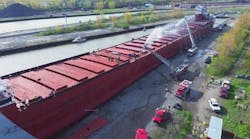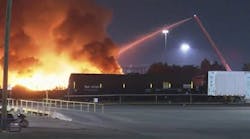There has been discussion recently about whether the focus on firefighter health and safety is impairing our ability to effectively operate at incidents. The concern is that the increased attention to health and safety may impair the fire service's overall goal to save life and property. Some are saying we are less aggressive now at fireground operations than we were in years past — "It's not like the old days riding on the back of a pumper to the fire."
No one would doubt that firefighting is inherently dangerous. Sometimes, even with the best information available, the best training and the best equipment, bad outcomes happen because we operate in an unstable environment. Our best efforts at gathering information and managing the incident in this dangerous and fluid environment may not be enough to avert a bad outcome that may be sudden and tragic. Leadership is about knowledge. It is also about managing the ever-changing calculus of risk versus benefit at any moment in the incident. We draw upon our firematic courses and personal experiences over our years in the fire service. We recall stories told by senior members or lessons written in articles read years before in Firehouse® Magazine or other journals. We ask the help of the others at the command post. We say a quick prayer that our decisions will be well guided.
Some lament that we are now a different leadership because we developed an institutional process to manage risk on a daily basis within the fire service. There are actions and policies off the fireground that directly impact the well-being of our firefighters. Unfortunately and despite all the advances in training, there are firefighters who are resistant to change. These naysayers believe that the health and safety of firefighters has never been a priority in fire service culture. It shouldn't interfere with their idealized version of reality where near misses are relived in firehouse lore. "Remember the time Bobby showed up at the scene straight from the bachelor party and the cops almost hauled him off? Wow, that was some night!"
Here are some examples that may leave you scratching your head.
• The physical fitness test is a basic standard of fitness and measures the ability to perform fireground duties. A career department in Connecticut required its members to annually pass a physical fitness exam identical to the one candidates take to be considered for hire. A line officer challenged that policy through the courts, claiming it was discriminatory, and the courts agreed. The policy was eliminated by the department.
The reasoning behind this decision is difficult to understand. The physical fitness test has been validated as an accurate representation of typical duties firefighters need to perform at fires. So why should some firefighters who respond to the same fires and perform the same tasks not be held to the same physical ability standard?
• A large volunteer department in New York State devoted significant resources to build and equip a fitness area in the firehouse. It took a couple of years to come up with the funds, but the commissioners spared no expense to have the finest equipment. They even hired a fitness instructor to train the firefighters on proper use of the equipment. They also had the trainer develop individual workout programs for each firefighter who asked for help.
The results were impressive for those who participated. Not only did they improve their health, but they spent more time at the firehouse and made more runs than members not in the fitness program. This improvement in response rates was very valuable to the department and the community since those members were immediately available to get the rigs crewed to respond.
Although some members used the fitness program each year it was offered, others complained it was a waste of money since only a few firefighters reaped the benefits. Those against the program actively lobbied the commissioners to fire the fitness instructor and use the funds for more conventional uses such as buying new plasma TVs with video games, new sofas and a more elaborate holiday party.
• A large metropolitan department attempted to implement a policy banning tobacco in the workplace for all firefighters. However, smokers pressured the administration to not adopt the policy. This occurred despite overwhelming evidence that smoking has detrimental effects on health and all the publicity concerning the hazardous aspects of second-hand smoke affecting the health of their fellow firefighters. This is regrettable since the smokers were offered help to quit smoking and the cost of tobacco products is enough to make a car payment.
• A line officer in charge of his station uses the kitchen sink to decontaminate his self-contained breathing apparatus (SCBA). This is the same kitchen sink that the members use to prepare their meals and wash the dishes. We wear SCBA at fires so we don't breathe all of the toxic fumes and particulates. In the process our gear gets coated with toxic particulate matter. The byproducts of combustion from today's fires are carcinogenic and this should be common knowledge. It is difficult to comprehend why the kitchen sink is being used when the station is properly designed and has a designated area in the bays with a sink to decontaminate gear. The officer's response when challenged is that he cleans up the area after each use.
We can favorably influence each of these scenarios. They directly affect the health of our firefighters. Health and safety has not gotten enough attention because the annual statistics on firefighter line-of-duty deaths do not count deaths from cancer or the long-term medical conditions resulting in a premature death. These statistics have not changed over the past 10 years.
Half of firefighter deaths are still due to cardiovascular disease and another 25% involve responding to calls, returning from calls or backing apparatus. This means that at least 75% of firefighter line-of-duty deaths annually may be preventable. This does not take into account firefighters who develop cancer and other diseases later in life due to occupational exposures, which may also be preventable.
Let's go back to the original question of whether the new focus on firefighter well-being has decreased our effectiveness to perform our mission to protect life and property. Our ability to operate on the fireground has not been impaired. It is worth noting that if you read the actions performed by the firefighters in the Firehouse® Heroism and Community Service Awards program (Firehouse®, April 2010), it appears that firefighters across the country are still bravely accomplishing the mission of protecting life and property in spite of the attention to health and safety.
The fire service has the ability to improve firefighter well-being off the fireground. Our efforts to improve the health of firefighters across the country with periodic medical evaluations, improving fitness, controlling cardiovascular disease risk factors, offering incident rehab and minimizing occupational exposures are all beneficial to the fire service. These efforts will improve the health of firefighters now and into their retirement. It also ensures that firefighters responding to fires are in better physical shape, in better health and their bodies are better prepared to handle the extreme physical demands that firefighting places on them.
For a long time, firefighter health and safety was an afterthought and not a priority in fire service culture. There are still firefighters resistant to efforts to establish health and safety policies. The reasons are likely varied; some may be worried that new policies could affect employment or cause them to be labeled unfit for active firefighting duties; they don't want to change their habits; or they just simply want nothing else to think about. Whatever the reason, that mindset is a roadblock to improving well-being of all firefighters.
Implementing policies to promote the well-being of firefighters and changing the status quo starts at the top. Fire service leadership should embrace firefighter health and safety. Culture is difficult to change, but it can change over time with persistence and strong leadership. It also takes guts to stand up for ideas that are not popular in your department.
The trend in firefighter health and safety started years ago. Our cabs are now enclosed, our trucks are more visible during the day and night, wearing SCBA and medical exams are now common practice. The focus on firefighter well-being has more momentum now than it did in the past. Department leadership needs to continue to pursue firefighter health and safety to continue the effort to reduce on-duty deaths.
As long as at least 75% of firefighter line-of-duty deaths are preventable, focusing on health and safety is not detrimental to the fire service. Strong leadership is needed to continue to make progress with health and safety initiatives and to change the culture of the fire service. After all, if it weren't for strong leadership at the turn of the 20th century, the chief would still be following the steamer in his horse and buggy.
DR. RAYMOND BASRI, MD, FACP, is in the private practices of internal medicine and diagnostic cardiology in Middletown, NY. Dr. Basri is a Diplomate of the American Board of Internal Medicine and president of the Mid-Hudson Section. He received the 2008 Laureate Award of the American College of Physicians, of which he is a Fellow. Dr. Basri also is clinical assistant professor of medicine at New York Medical College, attending physician in the Department of Internal Medicine at Orange Regional Medical Center and on the consulting staff in cardiology at The Valley Hospital in Ridgewood, NJ. He is a member of the Excelsior Hook and Ladder Company in Middletown and a deputy fire coordinator for Orange County. Dr. Basri is the senior physician of the Disaster Medical Assistance Team (DMAT NY-4). He is a senior aviation medical examiner for the Federal Aviation Administration (FAA) and chief physician for Health & Safety Specialists in Medicine, which does onsite medical examinations for the fire service and consultant to FirePhysicals.com. ERIC BERGMAN, PA-C, is a physician assistant practicing internal medicine at Hartford Hospital in Hartford, CT. He earned a bachelor of science degree in allied health from the University of Connecticut and a master's degree from Albany Medical College. He is a member of the Killingworth, CT, Volunteer Fire Company; a past company officer and life member of the Avon, CT, Volunteer Fire Department; and a past member of the Shaker Road-Loudonville Fire Department in Colonie, NY.





